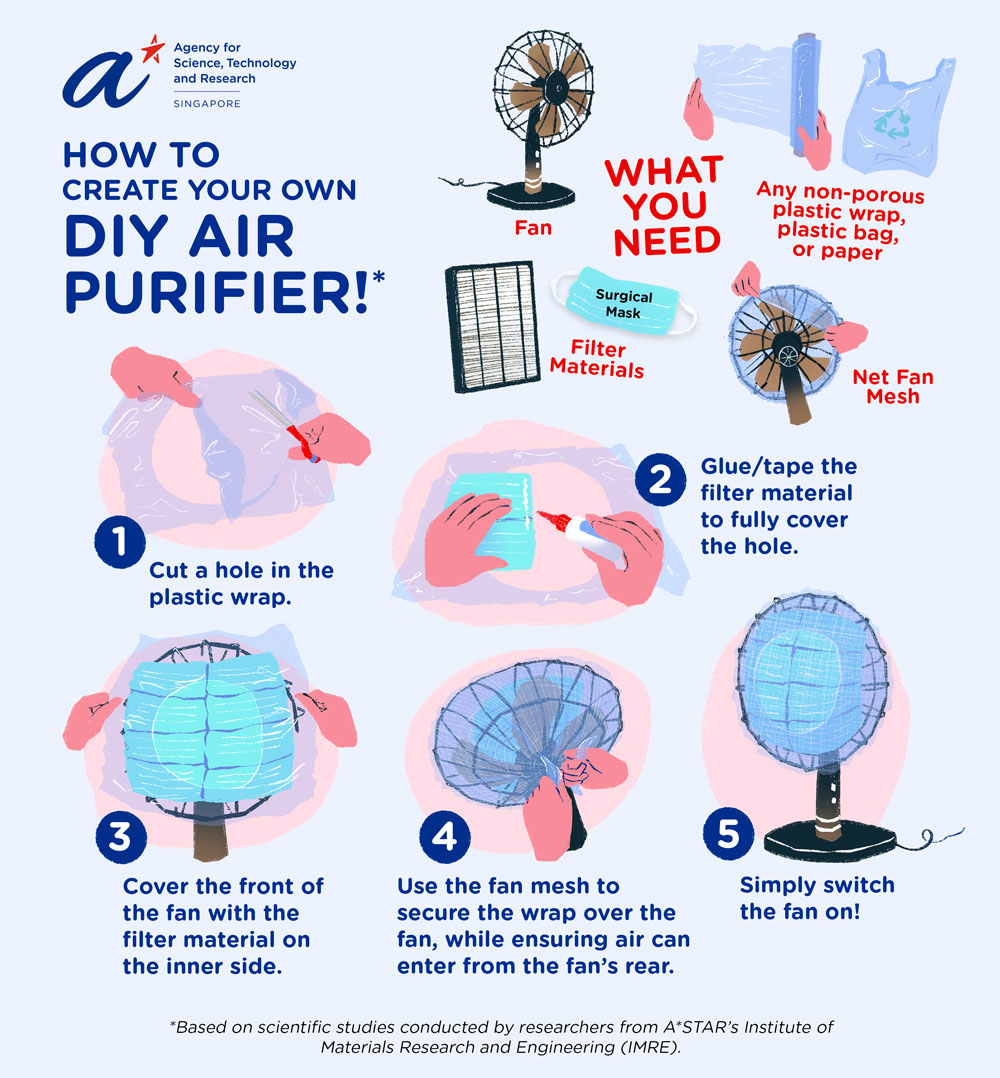The Science of DIY Air Purifiers
Scientists in Singapore have done research on additional preventive measures against the COVID-19 virus. One of these studies examined how proper ventilation in spaces is effective in reducing droplet and aerosol transmission, on top of the current safe management measures.
However, in indoor spaces where ventilation may not be optimal, air-purifying devices can help clean the air and reduce the risks of exposure to aerosols that may contain potentially dangerous pathogens. Not every household owns a commercial air purifier, but the good news is that people can put together their own DIY air purifiers at home using easily available items.
Materials scientists at A*STAR studied different materials that can be used together with a standing fan to create DIY air purifiers that offer of particle filtration of 80 per cent, and additional protection against COVID-19 transmission.
About the Study
A series of experiments was conducted to measure the filtration efficiency of a variety of materials such as HEPA filters, surgical masks, oil filters and melt blown polypropylene (PP) material (the material usually used to make the middle filtration layer found in surgical masks).
A*STAR scientists from the Institute of Materials Research and Engineering (IMRE) measured the filtration efficiency of the various materials using a sensitive particle counter and laser equipment. The studies found that these materials are effective in filtering aerosols of various sizes, including the 1 micrometre (μm) size, which is the most prevalent size of an aerosol generated by a human1.
Summary of Results
The table below summarises the results of the experiments conducted by scientists from A*STAR’s IMRE, regarding various filter materials which are easily available to those wanting to build their DIY air purifiers. Among the various materials tested, melt blown PP, HEPA material, oil filters and surgical masks all provided particle filtration* of around 80 per cent or more.
| Commercial Air Purifier |
Melt blown PP | HEPA | Oil Filter | Surgical Mask | |
| Aerosols of 1.0 µm size filtered | 96% | 86% | 84% | 81% | 78% |
| Air Changes per Hour (ACH) | 18 | 9 | 15 | 10 | 9 |
*Disclaimer: While the DIY materials provide considerable filtration efficiency, they are not comparable to commercially available air purifiers. Such materials used to make DIY air purifiers enable particle filtration of around 80 per cent or more. Melt blown PP shows a slightly higher efficacy than surgical mask because it can be cut into a single large piece covering the entire front side of the fan, resulting in a larger effective area for filtration.
#DidYouKnow How a DIY Air Purifier Works
As we know, a standing fan works by drawing air from its back and blowing it forward. Keeping this simple concept in mind, one can design a DIY fan filter by keeping the back of the fan unblocked. This way, air will continue to be drawn into the fan. The front part of the fan should be covered with filter material and plastic to ensure that the air only flows through the filter material.
Important to Note
- Wind speed matters: The speed of your fan will affect how fast your room can achieve a clean state for its air. In general, if the wind speed is set to the highest setting, it will clean the air in the room the fastest.
-
Indoor air changes per hour matters: While the filter materials are found to be effective, the air changes per hour (ACH) are directly related to both the clean air delivery rate (CADR) – in other words, the fan speed – and the size of the room.
ACH = CADR (m3/hour)/room volume in m3
ACH is how many times the entire volume of air in a room is changed in 1 hour.Based on the scientific data, it takes about 9-10 minutes for an average household fan to clean the air in a room of 20-30 m3 size (about the size of an average bedroom in Singapore flats).
- Fan to Purifier: The DIY method essentially converts a normal standing fan into an air purifier. As the air now passes through the filter material, the airflow rate of the fan will be reduced (less windy), for the benefit of cleaner air.
- Usability: As with all products, wear and tear is expected. Change the filter once a week for surgical masks / melt blown PP / oil filter material, and once every two to three months for HEPA filter material.
How do I assemble my own DIY Air Purifier?

Useful tip: Measure the materials and cut out the correct size to fit your fan. The materials should cover more than 75% of the fan for optimal coverage.
The overall cost of materials for making a DIY air purifier is expected to be in the range of $3 to $5 not including the cost of a standing fan.
Materials - What works and what doesn’t?
|
✓ Surgical masks ✓ Oil filters ✓ HEPA filters ✓ Melt blown PP |
✕ T-shirts ✕ Wet tissue material ✕ Cosmetic facial masks ✕ Tracing paper |
Enjoy making your very own DIY air purifier!
1 On average, aerosols emitted by a human when talking range in size from about 0.7μm - 2.2 μm.
A*STAR celebrates International Women's Day

From groundbreaking discoveries to cutting-edge research, our researchers are empowering the next generation of female science, technology, engineering and mathematics (STEM) leaders.
Get inspired by our #WomeninSTEM
